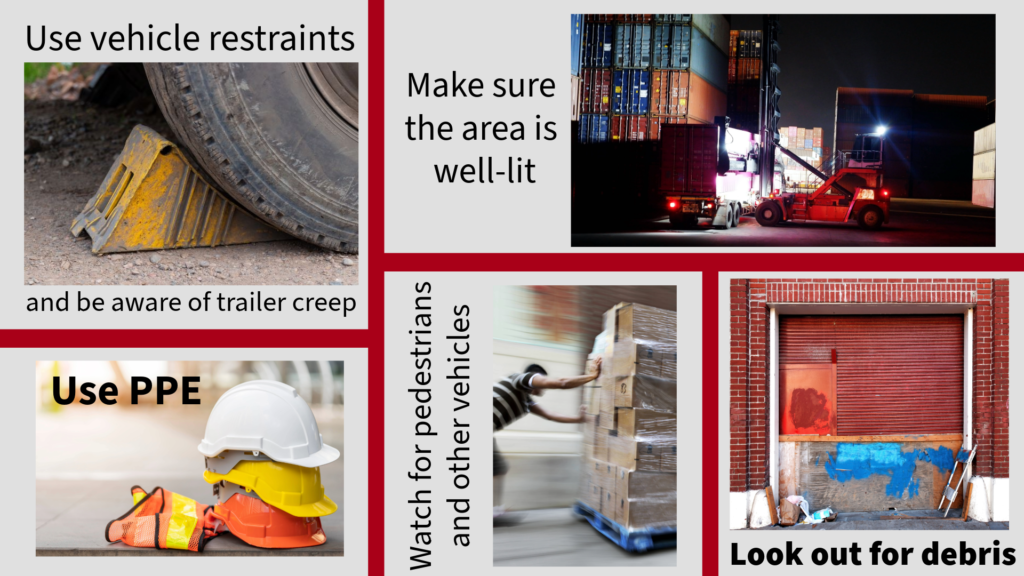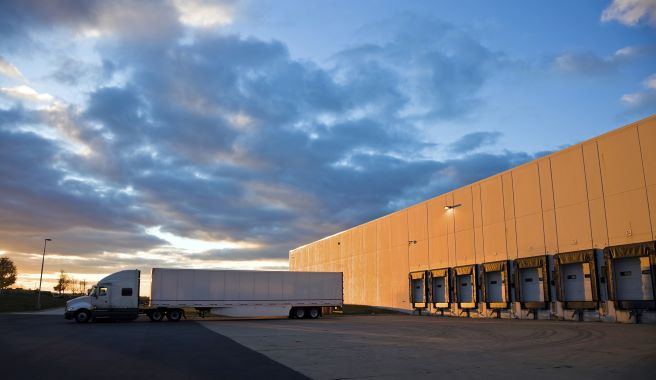Loading dock safety is a critical component of a well-functioning operation. It ensures that goods are transferred smoothly and securely from trucks to storage and vice versa. With heavy machinery, large vehicles, and constant movement of goods, loading docks present various hazards that can lead to serious injuries or costly damages if not properly managed.
Consider the following when planning load dock and yard safety awareness:
- Use vehicle restraints – When loading or unloading your vehicle, always shut off the engine and make proper use of all available vehicle restraints. There are many different kinds of vehicle restraint devices, but wheel chocks MUST be used as a minimum to prevent the vehicle from shifting and moving.
- Be aware of trailer creep – The repeated forces of loading or unloading a trailer can cause it to shift slowly over time, increasing risk of injury. To prevent this, check restraints and wheel chocks periodically and correct as necessary.
- Use personal protective equipment – Always use the appropriate personal protective equipment (PPE) for the job at hand/ worksite you are attending. Drivers and workers that need to wear PPE should be trained in its use, inspection and maintenance.
- PPE should be in good condition and well-fitted, and may include safety shoes, gloves, hard hats, or eye protection.
- Do not block exits – Be sure to never block any emergency equipment with your truck or trailer, even if you think it will only be for a few moments. Fire exits, (and lifesaving equipment such as fire extinguishers, sprinklers, first aid kits and eye wash stations) must be accessible at all times.
- Watch for pedestrians – Whenever operating your vehicle, watch carefully for distracted pedestrians and drive carefully.
- Vehicle traffic – Sometimes what wasn’t there when you started backing appears while you’re backing. If couriers or personal vehicles also are driving around you, you need to be aware of them. Continuously check while you are moving around at a customer’s yard to avoid unexpected vehicular traffic.
- Look out for debris and/or slippery surfaces – Loading docks can be busy places and that often means they can have stuff on the ground. Whether it’s discarded packing material or pallets make sure it’s cleared out of your path before you start moving around within the space. It’s also important to watch your step as you’re stepping down from your truck for icy surfaces.
- Make sure the trailer area is well-lit – You never want to be in a situation where you or others are moving around in dim or totally dark conditions as you try to load or unload the trailer. As a result, ensuring the whole space is adequately lit is a must for proper safety techniques.
- Pay Attention – Lastly, pay attention. Read the signs, pay attention to your surroundings, and make sure that you are respecting the loading dock workers, keeping yourself safe, and unloading your freight properly. Loading docks are not always the safest environments, and accidents tend to happen when people are distracted.

Spotter Communication
If you are a spotter there’s some important information to know to keep yourself and the driver safe.
- Agree with the driver on hand signals and gestures before you back up a truck. Do not use words as the word “no” might sound like “go” to the driver from many feet away with the truck running. You also want to ensure you both know when the action of backing is complete.
- Scan the area before backing to identify hazards and remove them before backing.
- Make sure you keep constant visual contact with the driver while the vehicle is in motion. If you lose sight of the driver, and you cannot see each other, stop immediately.
Dock Lights
A flashing red and green communication light system informs truck drivers outside and loading dock personnel inside about the status of the loading or unloading operations taking place helps to manage traffic flow and prevent unscheduled truck departures and trailer entries. The red and greed signals notify truck drivers when it is safe for them to pull away from the loading bay.
Here’s how they work:
- Red and green lights are universally understood to mean “stop” and “go”.
- When a truck is securely parked in the loading dock area, the inside light will be green, indicating to the forklift driver that it is safe for them to enter the truck trailer.
- When the light is green on the inside of the building, the outside light is red, indicating to the truck driver that they should not move.
- Once the truck trailer has been unloaded, the inside light will turn to red, indicating to the forklift driver they need to stay clear of the truck. Simultaneously, the outside light will turn green, indicating to the truck driver that it is now safe for them to pull away from the dock.
Related Legislation
Both federal and provincial legislation requires required monthly inspections of the loading dock area. Training records on equipment specialized to that department are also required.
Federal Legislation can be found here: Part 2: Permanent Structures
Provincial Legislation: While there isn’t legislation specific to loading docks, there are requirements related to equipment used near and hazards that may occur near loading locks. Those requirements can be found here:
- Powered Mobile Equipment: Manitoba Regulation 217/2006 Part 22
- Workplace Hazardous Materials Information Systems: Manitoba Regulation 217/2006 Part 35
- Chemical and Biological Substances: Manitoba Regulation 217/2006 Part 36
- SAFE Work Manitoba also provides a “Code of Practice for the Safe Operation of Powered Lift Trucks“
Need more information? RPM can help!
RPM offers a number of courses to help support your OHS plan. If this article was valuable to you or others at your organization, you may want to consider the following Program Development courses:
- Safety for Supervisors: Targeted for middle managers and front line supervisors, the objective of this course is to ensure supervisors are provided with information, tools and resources to effectively perform their safety and health roles and responsibilities. This course will cover topics such as legal responsibilities of a supervisor, due diligence, orientation and training, and safety culture.
- Hazard Identification and Risk Control: Recognizing what could injure workers on the job is the first step to ensuring that they stay safe. A proactive approach to the mitigation of workplace hazards greatly increases the chance of less severe and lower rates of injury. This course will provide students with the practical knowledge necessary to identify, assess and control the hazardous elements of their workplace so they can do their part in preventing dangerous incidents.
- Fleet Safety Managers: The Safety Manager role provides overall support and guidance to all areas of the organization. They coordinate with the leadership team in crafting short- and long-term strategies to build a culture of safety within the organization.
Proper training, use of safety equipment, and adherence to established guidelines can create a safer environment for all personnel involved. Prioritizing loading dock and yard safety not only protects workers but also enhances overall efficiency and productivity.
Visit SAFETY TALKS on our website for a pdf of this article, and many other resources!

